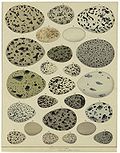Ornithology
Ornithology is the study of birds. A person who studies birds is called an ornithologist.
Aspects
Several aspects of ornithology differ from other disciplines, because they are easy to see and are often attractive. Many studies of birds have been done by amateurs working in a scientific manner.
History
Konrad Gesner wrote his Vogelbuch and Icones avium omnium around 1557. Later, England developed a tradition of ornithology. Francis Willughby, John Ray, Gilbert White, John Gould (who studied the birds of Australia) and Peter Scott are good examples.
What ornithologists do
Ornithologists typically trap birds for a closer look at them. This does not hurt the bird. Trapping birds can be done with in different ways, depending on the type of bird. For example, mist nets cause birds that fly into them to fall into a small pocket where the ornithologist can come back later and take a closer look.[1]
After the bird has been caught, the ornithologist will usually inspect (take a close look at) the bird. They may also attach a small ring to the bird's leg before releasing the bird. The ring allows ornithologists to study the bird's migration patterns, how long they live, and other information about the bird's species.[2]
Ornithology Media
A marbled godwit being ringed for studies on bird migration
A collection of bird skins, belonging to the family Cotingidae
Geese from a wall panel from the tomb of Nefermaat, Egypt c. 2575–2551 BC
Cover of Ulisse Aldrovandi's Ornithology, 1599
Antonio Valli da Todi, who wrote on aviculture in 1601, knew the connections between territory and song.
Quinarian system of bird classification by Swainson








